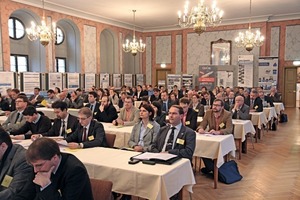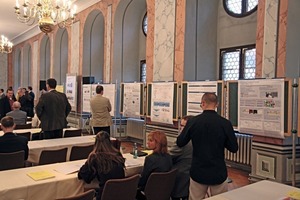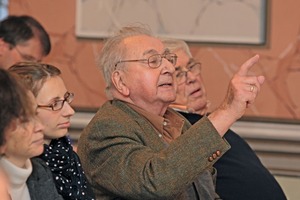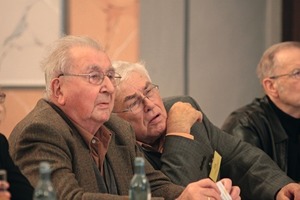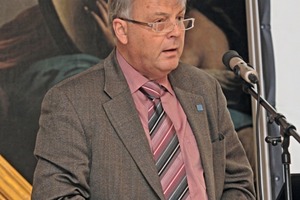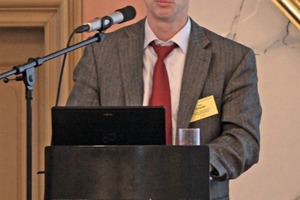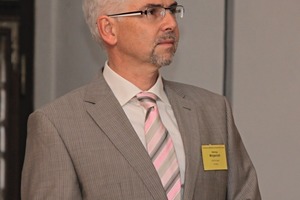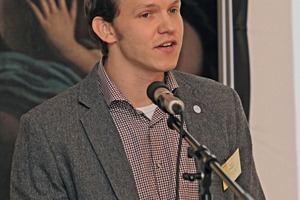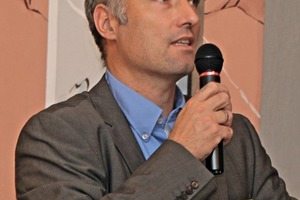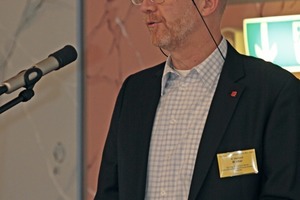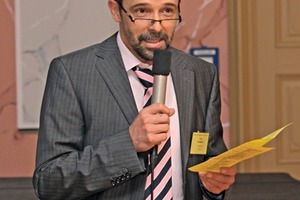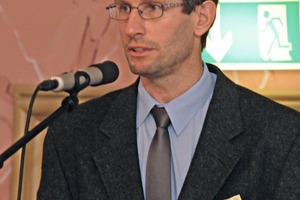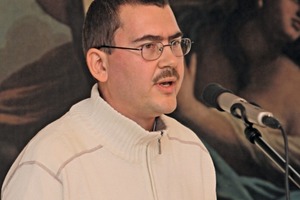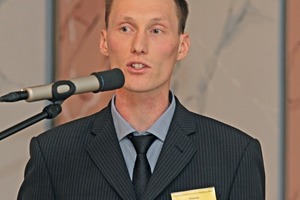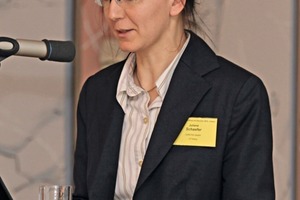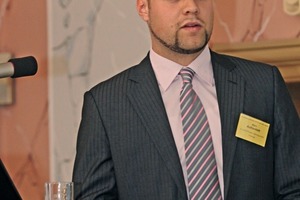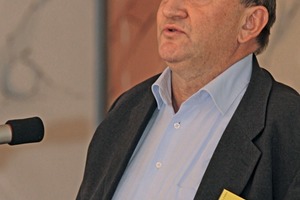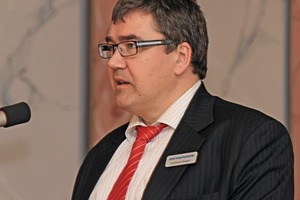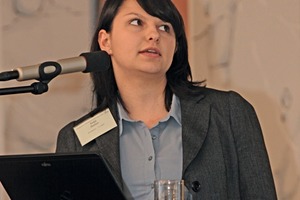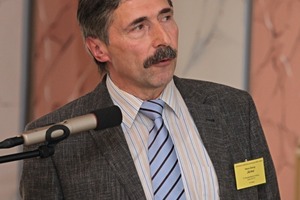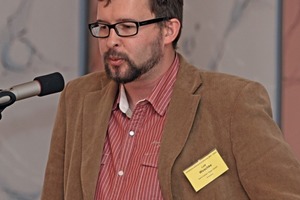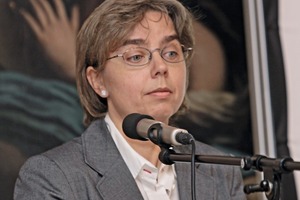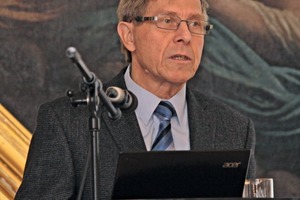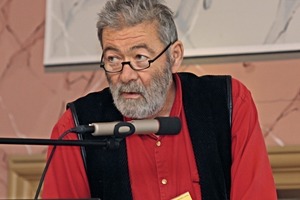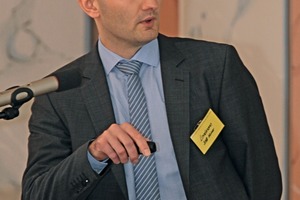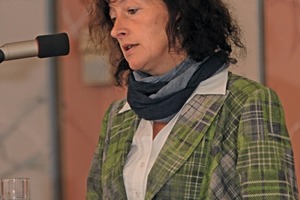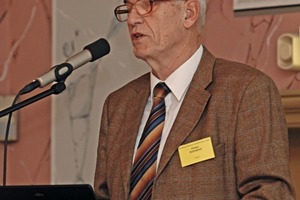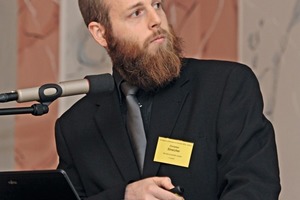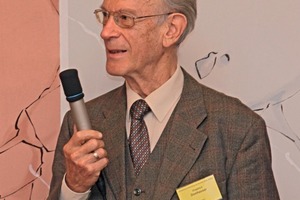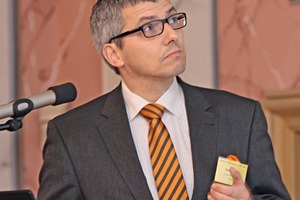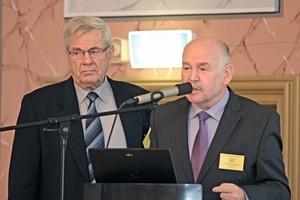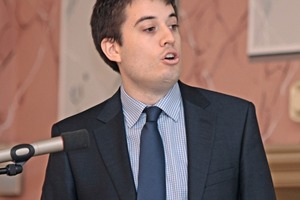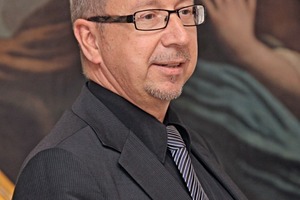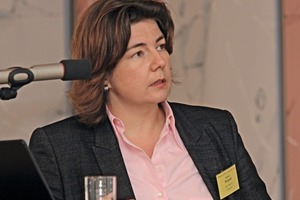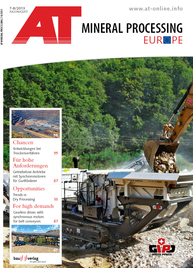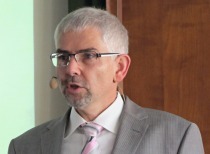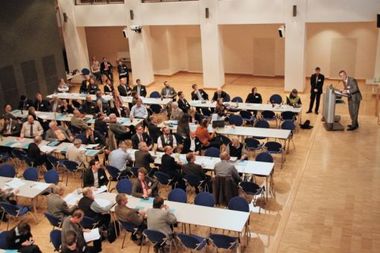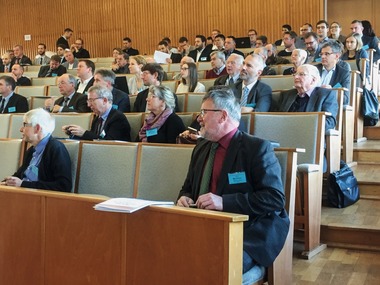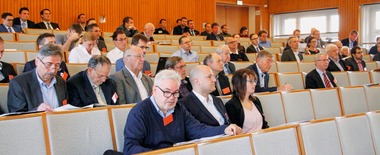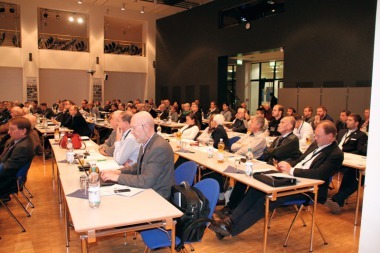Processing of primary and secondary raw materials
Conference “Processing and recycling”, Freiberg/Germany (7th and 8th November 2012)For many years the traditional events have been organized by the “Gesellschaft für Verfahrenstechnik UVR-FIA e.V. Freiberg” and “UVR-FIA GmbH” (Society for Process Engineering and Institution for Process Development, Environmental Protection and Recycling). This year for the first time the event was co-organized by the Freiberg-based Helmholtz Institute of Resource Technology (Helmholtz-Institut Freiberg für Ressourcentechnologie), which was founded in 2011. Due to comprehensive construction measures on the building of the former FIA Freiberg, the lecture hall of this building cannot be used. Therefore, the town Freiberg kindly offered its banqueting hall. The Lord Mayor Bernd-Erwin Schramm of Freiberg, which celebrated its 850th anniversary, welcomed the guests.
The conference was again met with an excellent response, which was proved by the presence of more than 150 scientists and experts from all over Germany and other countries of Europe. In 25 lectures and with 25 posters and presentations, renowned representatives from universities, research institutions and companies called the attention to problems of the extraction of local raw materials and the process engineering required for it. Furthermore, they reported on the recycling of valuable components from industrial and domestic waste as well as from building materials. Every lecture was followed by animated discussions, which were continued during the breaks and a soirée of the first day.
After the opening by the director of the Helmholtz-Institut Freiberg für Ressourcentechnologie, Prof. Dr. Jens Gutzmer, and by the managing director of UVR-FIA GmbH Freiberg, Dr.-Ing. Henning Morgenroth, the first lecture on “Flotation research at the Freiberg Helmholtz Institute” was given by Dipl.-Ing. Martin Rudolph, Prof. Urs Peuker and Prof. Jens Gutzmer. This lecture dealt with the flotation of minerals containing critical raw materials or which are characterized by a complex polymetallic intergrowth and, consequently, are difficult to process. They comprise different rare-earth minerals (bastnaesite, monacite, xenotime as well as eudialytes). First results were presented as regards the investigation of the mineral surfaces of valuable materials and intergrown tailings using modern analytical methods (e.g. tip-enhanced Raman spectroscopy TERS and inverse gas chromatography). These methods complement the investigations using established methods, such as the electrophoretic mobility (zeta potential), the infrared spectroscopy (ATR-FTIR) and methods to determine the dispersive and polar specific surface energies.
In their lecture “Processing of carbonate rare-earth ores” Dipl.-Ing. Gerhard Merker (Merker-Mineral-Processing Schwerte) and Dr. Andre Kamptner (UVR-FIA GmbH Freiberg) informed about selected ores and deposits as well as suitable reagent regimes of the flotation of local and foreign carbonate ores with the minerals bastnaesite, monacite, synchisite and parisite and about the separation of associated minerals, such as calcite, ankerite, dolomite and fluorite.
Dr. Uwe Lehmann (LfULG Freiberg) and Dr. Gerd Hagenguth (RHEIN MAIN KIES UND SPLITT GMBH & CO. KG) reported on „Some aspects of the additional extraction of placer gold in German gravel sand deposits”. There are endeavours for some years to extract placer gold as by-product also from “normal” gravel and sand deposits with an expenditure as low as possible. The concentration of free gold is clearly less than 0.1 g/t. Measurements in the Meißenheim gravel works of the company RMKS GmbH & Co. KG from the Upper Rhine in 2010 and 2011 resulted in a mean value of the gold content in the raw gravel of about 3 mg/t. A concentrate with a weight percent > 90 of flour gold was produced by means of a two-stage process (1st stage: coarse enrichment by means of carpets, 2nd stage: fine enrichment by means of honeycomb mats). Despite the obviously low gold content of German gravel sand deposits, an economic gold extraction is possible. The separation of other high-quality heavy minerals is also relevant.
Dipl.-Geol. Dirk Sandmann and Prof. Jens Gutzmer (TU Bergakademie Freiberg, University - Institute of Mineralogy; HI Freiberg) carried out “Geometallurgical investigations on mineralizations containing platinum-group elements at Sohland/Upper Lusatia” by means of the Mineral Liberation Analyser (MLA). First results permit the conclusion that the mineral particle sizes of the mineral phases containing platinum-group elements (tellurides/arsenides) are generally smaller than 10 µm and that the Pd-tellurides are particularly frequently intergrown with non-ferrous metal sulphides (mainly pyrrhotine and clearly less portions of pentlandite). The mineral grains of Pt-arsenide are intergrown with silicates in larger portions of one of the two evaluated samples. In the other sample the same happens with non-ferrous metal sulphides.
Dipl.-Ing. Thomas Leißner and Prof. Urs Peuker (TU Bergakademie Freiberg - MVAT) lectured on the “Investigation into the dry magnetic separation demonstrated by the example of a quartz mica greisen” with the main minerals quartz, zinnwaldite, topaz and muscovite. A successful separation of valuable and associated minerals is only possible with good mechanical opening-up and sufficiently large differences between the susceptibilities of the individual components of the mineral mix. The mass susceptibility was determined by means of a susceptibility balance (MSB MK II from Sherwood). The composition of the samples was determined by means of wet-chemical decomposition as well as spectroscopic measurements. The data obtained can be combined to evaluate the magnetic separation.
Dipl.-Ing. Juliane Schaefer and Dr. Henning Morgenroth (UVR-FIA GmbH Freiberg) reported on the “Processing of stock-piled materials from Mansfeld”. The goal of this process is to get a concentrate from a material with a relatively low copper content of about 0.7 % as well as from very fine intergrown copper minerals of the grain class 10-40 µm. After a sensor-based sorting to separate rock with a copper content of less than 0.2 %, a concentrate was obtained from this preliminary concentrate by means of comminution and very fine particle flotation. From this concentrate copper may be extracted hydrometallurgically.
In their lecture “Processing of screened limestone debris by means of a combined dry- cleaning drum” Björn Autenrieth, Gerd Stölzner and Mathias Trojosky (Allgainer Process Technology GmbH, Göppingen) presented the results of a comparison with rock washing plants including downstream dryers. The ALLGAIER dry-cleaning drum is distinguished by very good cleaning results and relatively low capital spending and operating cost.
The “Vitrification and utilization of mineral residuals” presented by Prof. Heiko Hessenkemper (TU Bergakademie Freiberg - IKGB) showed that there is an essential application potential in the field of solar thermal technology and photovoltaics. Based on the description of the manufacturing technologies, concrete examples were presented as regards the fields of photovoltaic carrier glass in the thin layer sector for CIS or CIGS modules as well as solar thermal collectors based on foam glass. Recent projects also deal with the possibilities to use the simple and cheap sea water desalination.
In his lecture “Fine glass processing using the Mogensen sorting technology” Dipl.-Ing. Eckhard Zeiger (Mogensen GmbH & Co. KG, Wedel) proved that the glass industry can be provided with fine glass with a so far unknown quality and quantity due to the consistent further development of the sorting technology and a tailored process and plant engineering. Thus, raw materials and energy can be saved. Now fine glass is no longer waste but a valuable raw material. With minor adaptations, this sorting technology may also be used for the processing of recycling plastics, inorganic mixed building waste and industrial minerals (limestone and salt).
In their lecture “Process design for the extraction of rare earths from fluorescent lamps” Dipl.-Chem. Peter Fröhlich and Prof. Martin Bertau (TU BA Freiberg - Institute of Technical Chemistry) as well as Katja Golon and Dipl.-Chem. Karin Jacob-Seifert (FNE Entsorgungsdienste Freiberg GmbH) informed about the current issue of recycling of rare earths. A few years ago, fluorescent lamps had still been deposited as hazardous waste. With the new process presented, the recovery of rare earths could considerably be simplified. In addition of an improved process economy, Y and Eu could completely be separated with a raw product purity of up to 99.0 %.
Dr. Hans-Georg Jäckel and Prof. Urs Peuker (TU BA Freiberg - MVAT) reported on “Peculiarities of the decomposition comminution of fine-structured composite materials demonstrated by the example of Li containing equipment batteries”. Based on a general classification of the composites and the presentation of suitable stress conditions or comminution technologies, respectively, for the decomposition of composites, they dealt with the specific decomposition comminution of Li containing equipment batteries. In particular, the hazard potential of Li batteries has to be taken into account. As a result of the investigations, a processing flow chart for Li containing equipment batteries was presented. It does not need any expensive thermal preparation.
Dipl.-Ing. Mirko Landmann (Institut für Angewandte Bauforschung Weimar gGmbH - Institute of Applied Construction Research) and Dr.-Ing. Hagen Müller (HAVER Engineering GmbH) reported on “Possibilities to remove adherent gypsum from mineral construction and demolition waste”. In particular construction and demolition waste containing gypsum building materials in the form of plaster or screed are becoming more and more a burden for the building materials recycling industry. One possibility to increase the recycling potential of gypsum containing construction and demolition waste is the recovery of the mono-fraction wall building material by means of a carefully controlled separation of the gypsum. This was investigated together with the companies UVR-FIA GmbH and HAVER Engineering GmbH. Due to attrition in an autogenous mill of SKET design, the gypsum components could be enriched in the fine particle range < 4 mm. Parallel to this, the sulphate content in the coarse particulate material of > 4 mm was decreased. The portion of gypsum in the usable, coarse particle range of recycling material of calcareous sandstone and vertically perforated bricks was also reduced by means of a selective comminution using the friction-clean from HAVER Engineering GmbH. The grain shape was maintained to a great extent during the stress.
Sewage purification was the topic of the lecture “Chitosan - bio-based flocculant for waste water containing oil and grease” given by Dr. Simona Schwarz, Sandra Schütze (Leibniz-Institut für Polymerforschung e.V. Dresden) and Jörg Bohrisch (Fraunhofer-Institut für Angewandte Polymerforschung IAP Golm). Chitosan is predominantly produced by the chemical splitting-off of the acetyl groups of chitin. This causes a large potential to bond greases and oils due to the cationic charges so that it is excellently suitable for the purification of sewage yielded in different industrial and business sectors. They informed about the results of the grease-bonding effect of various Chitosans and their derivatives.
In his lecture “Associations between the concepts and design of mechanical equipment for process engineering combined with thermal processes” Dr. Rüdiger Schramm (Dessau) explained the reciprocal associations demonstrated by the four examples: air-swept mill, V-separator, spray granulation and mixed cooling. Given the requirements of practice, a stronger connection of the macroprocesses of mechanical process engineering with the thermal processes would be desirable.
The energy efficiency of a grinding circuit essentially depends on the efficiency of the classification integrated in the grinding circuit. Dipl.-Ing. Christian Streicher, Prof. Helmut Flachberger (Montanuniveristät Leoben – chair of mineral processing and refining) and Peter Kindel, Tim Nowack (Christian Pfeiffer Maschinenfabrik GmbH, Beckum) reported on the “Optimization of dynamic separators for the mineral raw material industry”. By means of simulations with computational fluid dynamics (CFD), tests on cross-flow rotary basket jigs, as they are mainly used in the cement industry, were compared in a pilot plant with parallel tests carried out on a laboratory separator. Thus, they obtained data to improve the efficiency of grinding circuits.
The kaolin losses during the hydrocyclone classification are determined by the fines, which are discharged together with the water in the underflow. With their lecture “Hydrocyclones with controlled washing water injection for the kaolin classification” Wolfgang Rubarth*, Dipl.-Ing. Fred Donhauser*, Stefan Huber**, Hubertus Blaß**, G. Prollss***, E. Endres***, T. Neese*** (*AKW Apparate+Verfahren GmbH Hirschau; **AKW Amberg; ***FAU Erlangen-Nürnberg) presented an improved technology of the water injection into the conical part of the cyclone. This technology is particularly used for the kaolin processing in smaller cyclones. They demonstrated by examples that an additional hydrocyclone stage is not necessary, that the kaolin losses can be reduced by the half or that the kaolin output can be increased by about 20 %.
Prof. Dr.-Ing. Ralf Habermann and A. Straaten (Krefeld Niederrhein University, department mechanical engineering and process engineering) informed about first results as regards a “Comparison of individual and collective particle stress in impact mills”. They presented and discussed the individual and collective particle stress in a laboratory hammer mill, type LHM 20/16, from NETZSCH Condux Mahltechnik GmbH, Hanau, and a universal impact mill, type 100 UPZ-II, from HOSOKAWA Alpine AG, Augsburg, fed with pre-classified acrylic glass granulate and limestone chips.
Dipl.-Ing. Paul Clemens*, Dr. Dietmar Espig**, Dr. M. Pohl***, T. Sievert*** und Dipl.-Ing. Gunter Schnedelbach**** (*Mahltechnik und Automation Schöneiche, **Technologieberatung Freiberg, ***Dyckerhoff AG Wiesbaden, ****UVR-FIA GmbH Freiberg) presented the “Design of charge compositions for fine grinding compartments in tube mills” demonstrated by the examples of a three-compartment open-circuit mill from FLSmidth running at Märker Zement in Harburg and an open-circuit mill followed by closed-circuit high-pressure grinding rolls in the Geseke cement works of Dyckerhoff AG. The required data were obtained by means of a test program consisting of a variation of the stress duration, the used ball sizes (monodisperse and polydisperse) and the power requirement of the motor of an intermittently operating pilot plant mill. The grinding curves during an energy-equivalent stress duration, but varied grinding ball allocation, show significant allocations of the power requirement and the comminution result so that an energy-efficient grinding media composition and grinding compartment subdivision can be determined to ensure the required quality of very fine cements and to show the potential of energy saving.
With their lecturer “Comparison of comminution processes in vertical and drum mills taking into account the theory of the natural breaking characteristics” Dipl.-Ing. Paul Meissner and Dr. Andreas Böhm (Montanuniversität Leoben, chair of mineral processing and refining) allowed access to the current research activities of the chair of mineral processing and refining as regards the topic of fine comminution by means of drum and vertical mills. Problems of the energy efficiency in fine comminution were discussed based on the particle distribution with differently adjusted grinding plants compared to the “natural breaking characteristics according to Prof. Steiner” of different materials as well as to the grindability (surface development vs. specific energy consumption).
Under the headline “Intelligent control of fine grinding plants” Dr. Jürgen Stein and Gerhard Kiederle (Hosokawa Alpine AG, Augsburg) presented new findings as regards the optimization of the production performance, product quality, energy saving or operational stability. Efficient simulation programs offer the platform for a model-based consideration of the overall process. The knowledge-based approach is a good choice for the commissioning of new grinding plants or the performance improvement of existing plants. The real process data are acquired, evaluated and used for the control. An intelligent control is achieved by means of the control software “eeseeControl” in three steps, namely a first “learning phase” by means of data acquisition, then the “understanding phase”, in which the measured data are to be evaluated and decision structures be prepared, and finally the “optimization phase”, in which the process can adjust itself optimally due to the permanent return of relevant current measured data.
Dr.-Ing. Caroline Woywadt (Gebr. Pfeiffer SE Kaiserslautern) reported on “Operating experience gained with the new vertical roller mill MVR from Pfeiffer”. The new vertical roller mill MVR from Pfeiffer including MultiDrive® covers a capacity range of up to 12 000 kW using a maximum of 6 rollers and drive modules each. This corresponds to the demand of the cement industry for increasing capacities and availabilities of the plants as well as for a wide range of cement qualities. The entire range of capacities for the grinding of raw material, cement and granulated blastfurnace slag can be covered with five different roller modules and three different drive modules. The lecture also dealt with design details of the MVR vertical roller mill.
Dipl.-Ing. Lutz Wuschke, T. Stanossek and E. Gärtner (Saint-Gobain Rigips GmbH, Brieselang) reported on the “Activation of setting accelerators based on CaSO4*2H2O by increasing the specific surface”. To a great extent gypsum from flue gas desulphurization of coal-fired power plants has replaced natural gypsum as raw material for the manufacturing of gypsum plasterboard in Germany during the last 20 years. One essential parameter of the production capacity of a plasterboard factory is the setting time, which is controlled by the addition of so-called accelerators and reduced as far as possible. The accelerator is produced by grinding a mixture of dried, not calcined FGD gypsum and dextrose in a ball mill (6 m length, 1.6 m diameter). Thus, a large specific surface, which is responsible for quick setting, is to be achieved. Based on laboratory tests (Bond ball mill and laboratory ball mill, Rigips design), mill parameters, such as grinding media size and filling ratio, feed material filling ratio as well as the relative speed, are varied to produce an accelerator as active as possible. The activation effect is evaluated by means of a calorimetric method. Based on these investigations, they succeeded in determining suitable grinding condition for the technical process so that the plants will achieve the required throughput.
Dr. Annegret Potthoff and K. Lenzner (Fraunhofer Institute for Ceramic Technologies and Systems, Dresden) reported on the “Influence of the energy input on the granulate properties during processing”. For this purpose they used nano materials of zirconium oxide in part stabilized with Y2O3, which is used, for example, in the high-temperature fuel cell, for the sensor technology or for dental ceramics. In the sequence “agitating - mixing - grinding” the raw material was mechanically treated and a deagglomeration and deaggregation of the starting material was achieved step by step. A comminution of up to a particle size x50;3 of 100 nm was achieved in an agitator ball mill with a maximum specific energy input of 3.7 kWh/kg. By means of X-ray structure analyses and the identification of the ionic concentration in solution they showed that a crystalline phase transition takes place and that Y2O3 is dissolved out from the raw material, in addition to the desired comminution as a function of the energy input.
Dr. Detlef Höhne and Dr. Dirk Schubert (SF Automotive GmbH & Co. KG) dealt with the test of “Alternative materials for process engineering investigations”. They tested inert powders with a behaviour in the corresponding processes that coincided as far as possible with that of the explosive original materials. For this purpose, the flow properties of two explosive powders were characterized by means of a special shearing device, type RST-XS. Then they were compared with the results obtained with 13 inert fine-grained powders and an order of the suitability as alternative materials was determined. To achieve an even better accordance with the flow properties of the alternative materials with the original ones, they tested mixtures of various individual substitute powders further reducing the mean relative deviations.
In their lecture “Separation of very fine materials by means of the multi-gravity separation table MGS” Dipl.-Ing. Michael Bräumer and G. Childs (Company Bräumer, Bendorf) presented a solution for the density sorting of very fine particles focussing on a particle size of 5-80 µm (max. 500 µm) with a feed concentration of 30-40 wt.-%. Due to the centrifugal force of a rotating drum, the gravity is multiplied. At the same time, the drum is axially moved with a shock so that a sorting effect occurs as with the shaking table. The heavy material is continuously conveyed to the top towards the heavy material discharge by means of a conveying spiral attached to the drum wall. The light material is displaced to the bed surface at the top towards the drum axle and is discharged in free drop towards the bottom side due to the adjustable inclination of the drum axle.
The Freiberg-based Helmholtz Institute of Resource Technology took the opportunity to present its current fields of research with 12 posters. Further interesting new results were presented by the Dresden-based Leibniz Institute of Polymer Research in cooperation with UVR-FIA GmbH Freiberg and TU BA Freiberg, by Weimar Bauhaus University in cooperation with further partners, by TU BA Freiberg in cooperation with Fraunhofer institutes, by the IFG Institute for Scientific Instruments GmbH Berlin in cooperation with BAM Berlin and other partners as well as by the Institute of Resource Ecology, HZDR and the Jena Friedrich Schiller University.
The following companies were represented with presentations: Maschinenfabrik Gustav Eirich GmbH & Co. KG, EUROFINS Umwelt Ost GmbH – Niederlassung Freiberg, Fagus-Grecon Greten GmbH & Co. KG – Alfeld, FLSmidth Wiesbaden GmbH – Walluf, HOSOKAWA ALPINE AG – Augsburg, LAARMANN Deutschland GmbH – Solingen, MOGENSEN GmbH & Co. KG – Wedel, ALLGAIER PROCESS TECHNOLOGY GmbH – Uhingen, ZEMDES GmbH – Dessau-Roßlau.
The next lecture event with the main topic “Processing and Recycling” will take place in Freiberg on 13th and 14th November 2013. Again verbal lectures, posters and company presentations will be on the agenda. The organizers will be the „Gesellschaft für Verfahrenstechnik UVR-FIA e.V. Freiberg“ and the „Helmholtz-Institut Freiberg für Ressourcentechnologie“.
Author: Prof. Dr. habil. Hanspeter Heegn, Freiberg/Germany

